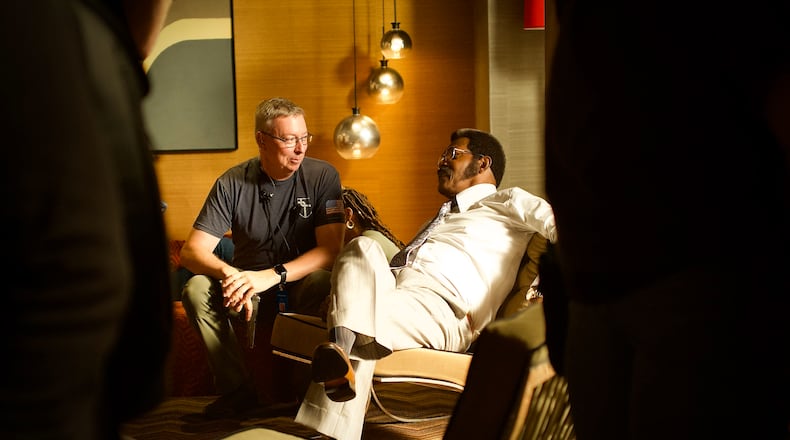Gordon Burrows has done almost everything there is to do with guns. Firing them, fixing them, cleaning them, building them. He spent most of his life in the military and in law enforcement, and later worked in the firearms industry.
About six years ago, Burrows was asked if he’d consider taking film and TV work. Hollywood — or Atlanta’s version of it — was the last place he thought he would end up. But it dawned on him that that was the one thing he hadn’t done with firearms: work with them on the set of movies and shows. So he obliged, sought training and began working on productions requiring specialists.
Burrows, who lives near Macon, is an armorer who has worked on a number of films and TV series that have filmed in Atlanta, most recently the gun-heavy “Fight Night: The Million Dollar Heist,” which chronicles an armed robbery on the night of Muhammad Ali’s 1970 comeback fight in Atlanta.
Armorers are in charge of handling, storing and maintaining all firearms on set and educating the cast and crew members on how they’re being used, among several other responsibilities. When a gun is needed in a scene, they’re the ones giving it to the actor and ensuring they know how to fire, unload or holster it — whatever action the scene calls for. They’ll have conversations with other departments, whether it’s wardrobe or with the director, about tweaking certain elements of the story or how a character presents themselves to ensure accuracy. They understand the vision the director wants to achieve and help to carry it out in a safe manner.
It’s a role Burrows is proud to hold and takes seriously, backed by 30 years of real-world experience. He gets the same satisfaction from working on set that he did training people during his time in the military and law enforcement.
“I felt it was my calling to be a teacher and instructor,” Burrows said. “Working on film sets, I realized I get to do the same thing now. Actors appreciate that. They realize what I’m telling them is legitimate.”
Renewed concern over safety
An armorer is not a new role in Hollywood. But its responsibilities and the practice of using real weapons on set overall were thrust into the spotlight after the fatal shooting in New Mexico on the set of “Rust” in 2021. Actor Alec Baldwin was rehearsing with a prop revolver when it fired a live round, killing cinematographer Halyna Hutchins.
The incident reignited discussions over occupational safety in the film industry. Several changes were enacted. California Gov. Gavin Newsom signed a bill requiring minimum training standards for people who oversee firearms on set. The most recent contract between the union representing crew members — the International Alliance of Theatrical Stage Employees — and Hollywood studios and streaming companies included new language that detailed firearms are the responsibility of the property master or a skilled, properly-licensed technician. IATSE also created two new positions to ensure the safe use of firearms on set and represent the union in legislative hearings and other regulatory matters.
Fatalities or injuries involving firearms on the set of productions are rare. Between 1990 and 2014, there were 251 on-set accidents in the United States and at least 44 deaths, the Los Angeles Times reported in 2015. Only three were related to firearms. But incidents can occur when just one person fails to follow the best practices or if there is a defect on the gun itself.
Entertainment unions have long maintained guidelines for the safe use of firearms on set, the key mantra being to treat all firearms as if they were loaded. This is Burrows’ approach. Safety is a top priority, above his desire for authenticity and realism, and a key part of making what he calls his artwork.
“Everyone on set is part of a team. The actors, the director and the crew. We’re all putting together a painting we want to show to the public and we want them to like,” Burrows said. “If I’m not helping to contribute to that, and I’m providing them the wrong firearm, and I’m not pointing out to them that they should do this or that, then I’m failing.”
Guns vs. gun replicas
Guns are an inescapable part of American film and television, from the spaghetti Westerns of yesteryear to high-octane Tom Cruise numbers. They make for good entertainment, creating tension, action and conflict, all elements critical to keeping a viewer’s attention.
There are all types of guns used on film and TV sets, each one serving a distinct purpose. Rubber guns, which are made from a mold of a firearm, are typically used in stunt work and look realistic at a far distance. Similarly, a replica made of metal, plastic or wood looks realistic if not seen up close, but cannot accurately depict gun-handling maneuvers. Airsoft guns, which are made to fire plastic or metal pellets (though can be reconfigured to not fire projectiles), can be more realistic looking than other replicas, but not in close-up shots where they will be loaded or fired.
The two options that have the closest resemblance to a real firearm are deactivated guns, which have been reconfigured to not fire blanks or live ammunition, and blank-firing guns, which only fire blanks — both of which have a realistic recoil, sound and flash. (The gun used on the set of “Rust” was a functional Colt .45 revolver mistakenly loaded with live ammunition that was present among so-called “dummy” rounds, according to Reuters). It’s illegal to have a firearm regulated under the National Firearms Act on set without a licensed representative present.
Using blank-firing guns is often a practical and economical option for productions, especially for lower-budget, gun-heavy projects. Adding visual effects or CGI to replicate smoke, shell casings and the flame in postproduction can be costly or time-consuming. Plus, you can’t computer-generate the slide locking to the rear when a gun runs out of bullets — at least convincingly.
“When I watch shows, I can pick out the fake plastic guns,” Burrows said. “A lot of directors want the authenticity and that look. If you do it correctly and you follow the safety guidelines, you won’t have any problems.”
On the set of “Fight Night,” Burrows said they mostly used deactivated guns and added the effects of gunfire in postproduction. At the end of every production day, Burrows would store them away in a lockbox only he has the key to open.
Credit: Parrish Lewis/Peacock
Credit: Parrish Lewis/Peacock
A day in the life of an armorer
Burrows typically begins his day on set by pulling the guns needed for scenes out of the lockbox and checking to ensure they’re unloaded, a task he completed the day beforehand. If they’re rubber or plastic replicas, he’ll perform the same check to ensure that they are indeed rubber or plastic.
Before he puts the gun in the hands of the actor who will be using it, he has a minimum of three other people do the same safety check. This is usually the first assistant director, the key grip or the prop master or their representative. He’ll then show it to the actor before handing it to them and encouraging them to check it themselves.
When Burrows practices with an actor to properly handle a gun, he is inclined to provide details that go far beyond what they’ll need in the scene. He’ll explain the history of the particular gun, how it operates and why exactly their character is using that particular make and model. Sometimes he’ll suggest an actor change their body language or the way they carry the gun to be more like their character. Actors may not instinctively know that a criminal worrying people are constantly chasing after him would put a gun on the table facing the door so he could easily reach for it, for example.
He’s noticed actors appreciate this, even if it seems like overkill at first. While filming “Fight Night,” an actor approached Burrows for help with a handling a shotgun in an upcoming scene because he didn’t have any experience with one. They scheduled a time, and Burrows taught him how to fire one, the proper way to position it on his shoulder and how to load and unload it. After they shot the scene, the actor approached Burrows and said that he initially wondered why he was giving him all of this information irrelevant to the action in the scene. All he wanted to know was how to fire the thing. But when cameras started rolling, it all clicked for the actor.
“If I’m working somewhere where they’re like, ‘Gordon, we don’t care about all that stuff. We just need you to hand out the guns,’ then that’s fine, if that’s what you want,” Burrows said. “But that’s not what I want to be. You can hire somebody else to do that.”
After several conversations and being approached by numerous people on set, Burrows was inspired to create a company focused on providing actors and film industry professionals a place to get training, technical expertise and anything else they might need related to the use of guns in film. It’s called Take One Tactical.
“As people come to town to film, I can provide them with a service they can take advantage of,” Burrows said. “Maybe they can have more of a reason to come back here.”
A version of this article first appeared in the AJC’s entertainment industry newsletter, The Scene, which you can subscribe to at qr1.be/V6U4.
About the Author
Keep Reading
The Latest
Featured





